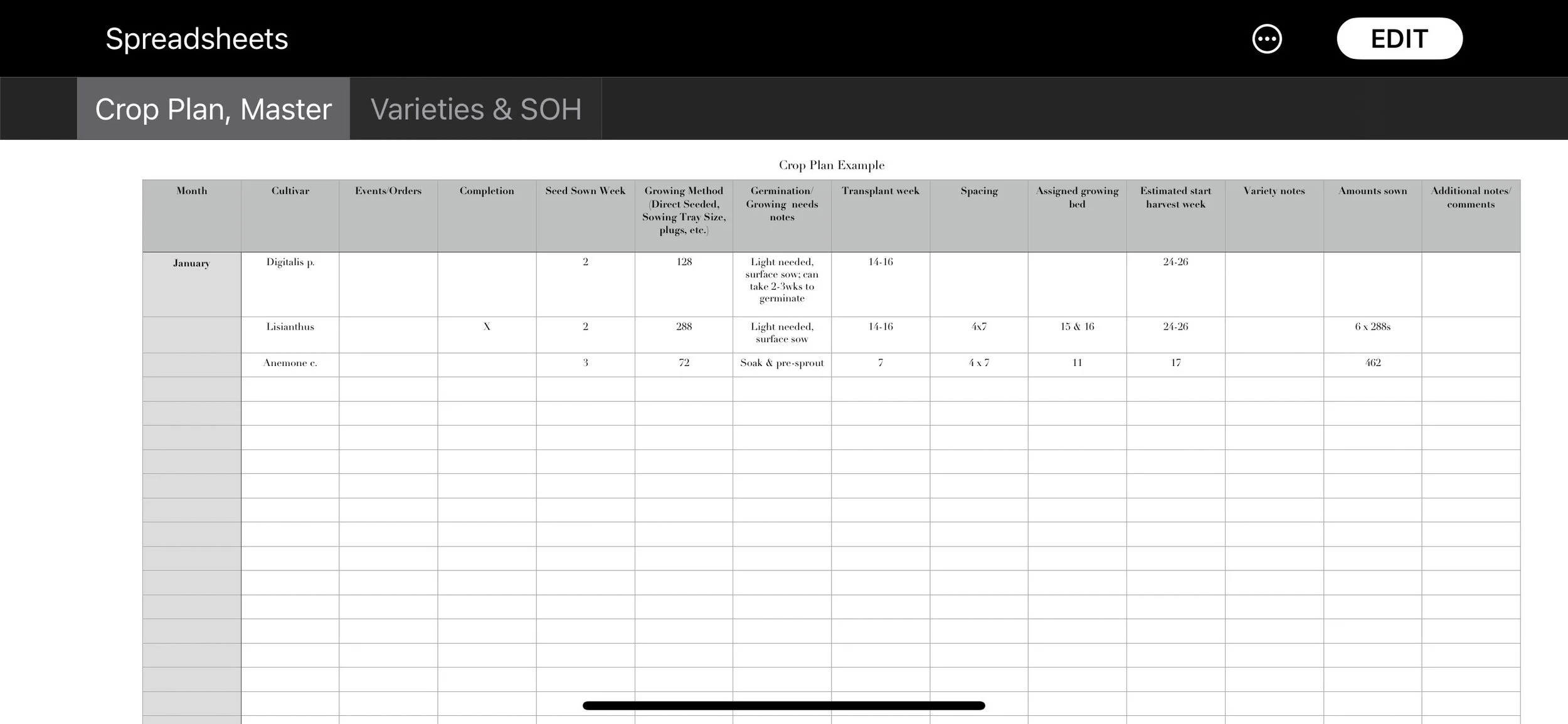Advanced Crop Planning: Succession, Rotation, and Tracking Systems
Ready to level up your crop planning? Advanced techniques like succession planting, crop rotation, and tracking systems can transform your flower farm. These strategies go beyond the basics, helping you maximize your space, extend harvest windows, and improve long-term soil health. Whether you’re growing for markets, events, or personal projects, this guide will give you the tools you need to refine your plan and take your farm to new heights.
Vincent Fresh and Vincent Choice sunflowers blooming beautifully in their row as this round finishes up, but with succession planting, sunflower season is far from over!
Succession Planting: Timing for Continuous Harvests
Succession planting ensures a steady supply of blooms throughout the growing season. By sowing the same crop multiple times at intervals, you can avoid production gaps and maximize your harvest. This strategy is particularly useful for market growers or event florists who need consistent availability.
Key Benefits of Succession Planting:
Continuous Harvests: Maintain consistent production throughout the season.
Optimized Space Usage: Maximize yields by staggering plantings within the same bed.
Adaptability: Tailor sowing schedules to align with market or event demands.
Example: Single-stem sunflowers are a prime candidate for succession planting. Sow new successions every one to two weeks to ensure a continuous supply of blooms throughout summer.
When to Pull and Replant:
Deciding when to remove old crops can be tricky without experience. For prolific bloomers like cosmos or zinnias, plants typically peak after three to four weeks of production. At this point, the next succession should be ready to take over. Monitor pest and disease pressure closely—if issues arise, pull and replace crops to protect the rest of your field.
For slower producers, such as foxglove (Dalmatian or Camelot series) or snapdragons, staggered successions ensure one planting is recovering while another is producing harvestable stems. Single-stem crops like sunflowers are simple: once harvested, turn the bed over for the next planting.
Pro Tip: Keep detailed notes on each crop’s lifecycle to refine your succession timing over time.
Want to learn more? Check out our Simplified Succession Planting Guide and Advanced Succession Planting Strategies.
A muted pink zinnia ready for harvest. We like to plant 2-3 successions of zinnias to manage powdery mildew and pest pressure. Early in the season, having plenty of extra seedlings helps combat nibbling earwigs and other pests.
Crop Rotation: Sustainable Growing for Long-Term Success
Crop rotation is a cornerstone of sustainable flower farming. It involves changing the crops planted in each bed from season to season or year to year, improving soil health while reducing pest and disease pressure.
Key Benefits of Crop Rotation:
Soil Health: Balances nutrient depletion and minimizes the need for synthetic fertilizers.
Pest and Disease Management: Disrupts pest life cycles and reduces disease buildup.
Better Yields: Promotes stronger, healthier plants over time.
How to Plan Crop Rotations:
Divide your beds into thirds or fourths to accommodate different seasonal crops (e.g., spring, summer, fall).
Rotate plant families to prevent nutrient depletion and pest buildup.
Example: Follow tulips (bulbs) with zinnias (heat-loving annuals) and finish with cover crops (green manure).
Plan for space to rest or use silage tarps and green manure for soil recovery.
In Practice:
In May, as tulips and narcissi finish, replant beds with early summer crops like cosmos or zinnias. By July, replace fading spring crops with fast-growing summer fillers (e.g., single-stem sunflowers) or fall crops like ornamental cabbage. After July, focus on quick-turn crops to make the most of the remaining season.
Want to Learn More?
Dive deeper into the art of crop rotation and how it can transform your flower farm in our Crop Planning and Rotation Guide. Discover practical tips and real-world examples to optimize your growing space and ensure long-term success.
Assessing wintered-over heirloom mums in the propagation house. My trusty calendar and notebook are always close by for jotting down notes and planning rotations as I work.
Tracking Systems: Streamlining Advanced Crop Planning
Effective crop planning relies on accurate tracking systems to manage successions, rotations, and harvest schedules. Whether you prefer digital tools, traditional methods, or a mix of both, tracking ensures nothing falls through the cracks and gives you valuable data for future seasons.
Why I Prefer Spreadsheets
While farm management apps can be convenient, I prefer spreadsheets because they give you complete control over your data. With spreadsheets, you always own your information and can customize your setup to fit your needs without worrying about subscription fees or losing access.
Thanks to the many smartphone and cloud options available, it’s incredibly easy to input notes or updates on your phone or computer and have them sync seamlessly. That said, there’s still something charming about using good old pencil and paper for quick notes when inspiration strikes.
Benefits of Spreadsheets:
Customization: Tailor your tracking system to specific crops, bed sizes, and timing needs.
Cost-Effective: No ongoing fees or reliance on external platforms.
Flexibility: Easily adapt as your operation grows or priorities shift.
What I Track in My Spreadsheet
A good tracking system should give you a clear picture of your farm’s progress and help you stay on top of your goals. Here’s what I track in my spreadsheet:
Amount of Plants Sown vs. Needed:
Calculate how many plants you need for each crop based on your goals.
Track how many you sow, accounting for extras to offset germination rates.
Germination Rates:
Monitor the success of each crop’s seed lot to refine future sowing calculations.
Example: If a batch of zinnia seeds germinates at 85%, I adjust my sowing quantity accordingly for the next round.
Yields:
Track how much each crop produces.
Example: Snapdragons typically yield X stems per plant over their lifecycle.
Assigned Growing Bed:
Document which beds are assigned to each crop to ensure proper rotations and avoid overcrowding.
Propagation Method and Tray Size:
Note whether each crop is direct-sown or transplanted and what tray cell size was used for seedlings.
Include any planned dates for bumping up seedlings into larger cells or pots before transplanting.
Cultivar Color/Variety:
Record specific details about each cultivar, such as color or variety. This is especially useful for event-focused growing where certain colors are in demand.
Succession Number:
Keep track of which planting corresponds to which succession. For example, note whether it’s the first, second, or third round of planting for a particular crop. This ensures you’re keeping rotations and harvests aligned.
Week Numbers and Notes:
Organize your tracking system by week numbers, which simplifies succession planning and aligns with your broader schedule.
Add notes for each week, including upcoming holidays or events that may impact planting or harvesting. For example, flag Valentine’s Day or a major wedding in Week 6 to ensure crops align with those dates.
Special Growing Needs:
Note specific germination requirements, such as whether a crop needs light or darkness to germinate.
Include reminders for unique conditions like soaking seeds or maintaining specific temperatures.
Additional Notes:
Track anything unexpected, such as crop failure, pest pressure, or perfect growing conditions.
These observations are invaluable for refining your process over time.
Pro Tip: Taking photos of first blooms for each crop and noting them in the corresponding week adds a visual timeline to your records and helps with planning future seasons.
A quick cheatsheet to easily convert Days to Maturity (DTM) to Weeks to Maturity (WTM).
Other Tracking Methods
While spreadsheets are my go-to, there are other methods that might suit your workflow:
Notebooks: Great for jotting down notes in the field. I like having one with a calendar and large squares for notes, which helps maintain a timeline reference over the years.
Whiteboards: Ideal for visualizing plans in a shared workspace or organizing tasks for the week. This is especially helpful when working with a team.
Phone Notes or Apps: Use your phone to snap pictures, log observations, or quickly document ideas. Apps like ASANA and Notion are also useful for tracking tasks and staying organized.
Ready to Simplify?
If setting up your own system feels overwhelming, we’ve created a Crop Planning Template to make it easier. This spreadsheet is designed specifically for flower farmers to streamline sowing schedules, yields, and target dates. It’s available exclusively through our newsletter.
Want to see it in action? Check out our Tools and Templates for Crop Planning blog, where we walk through how to use this resource effectively.
Spring elegance in full bloom: blush peonies, salmon ranunculus, black-centered anemones, sweet peas, white peonies, Bells of Ireland, and lavender bachelor buttons come together in these lush compote and urn arrangements. Careful crop planning ensured these blooms were perfectly timed for harvest and design.
Planning for a Successful Season
You’ve just taken a deep dive into advanced crop planning techniques—succession planting, crop rotation, and tracking systems—all designed to help you get the most out of your flower farm. These strategies provide the tools you need to stay organized, boost productivity, and grow with confidence.
Next Steps:
If you’re ready to refine your planning even further, check out these resources:
Tools and Templates for Crop Planning: A step-by-step guide to setting up your own tracking system.
With these techniques and resources in hand, you’re well on your way to a successful growing season. Here’s to planning smarter and growing better!
We are looking forward to sharing more blooms with you soon.
Jessica & Graham







